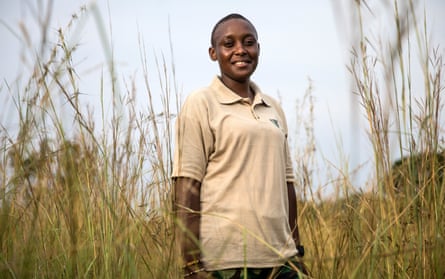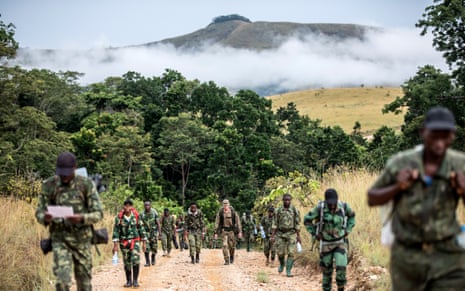Deep in the steamy rainforest of Gabon, a poaching gang’s night-time fire is smouldering and two long elephant tusks lie among the tangled roots. The axe that hacked them off lies nearby.
Just after dawn, the insect buzz and bird chatter is suddenly pierced by a whistle blast and camouflaged park guards burst out from their forest cover, swiftly pinning the poachers to the ground.
It is an exercise, part of training being given by the British army to Gabonese park guards. But the ongoing slaughter in Gabon is all too real: a dozen elephants are shot every day by heavily armed ivory poachers.

Gabon is the green jewel in the crown of the vast Congo rainforest, with 88% of the nation’s territory still covered in forest. Gabon also hosts 50-60% of the world’s remaining 45,000 forest elephants, the smaller, rarer cousin of the savannah elephant.
But across west Africa, more than two-thirds of the forest elephants have been killed in the last decade, ranging from 95% in the Democratic Republic of Congo to 30% in Gabon. Their ivory is harder, allowing more intricate carving, and so particularly prized by traffickers.
Quick GuideHow big is the ivory trade?
Show
Isn’t the ivory trade illegal?
The international trade in African elephant ivory was banned in 1989, after populations had plunged by half in 50 years. However the killing of elephants continued, with criminal gangs smuggling supplies to Asia, where ivory carvings have long been prized. Until recently, it remained legal to sell ivory within key countries like China, providing an easy way of laundering illegal tusks.
Are domestic ivory bans having an effect?
China, Hong Kong, the US, UK and others have either banned the ivory trade within their countries or are in the process of doing so, but it is too soon to assess the impact. The most recent authoritative report by monitoring body Traffic found that elephant poaching in Africa in 2016 had fallen, continuing a decline that began in 2011. But many dozens of elephants are still killed every day and the total population, now just 400,000, is still falling. 2016 saw the biggest amount of ivory illegally traded, perhaps as sellers tried to offload their stock as domestic bans became imminent.
How can the trade finally be stopped?
Further crackdowns on poaching and the corruption that enables smuggling is vital, as is enforcement of existing laws, particularly in the transit countries between Africa and China. Illegal markets serving mostly Chinese buyers in Laos, Myanmar, Japan and Vietnam must be closed. Online sales also must be better policed. Lastly, a new trafficking tactic must be tackled: the shift of ivory carving to Africa, which results in object that are smaller and much easier to smuggle than whole tusks.
Halting the grisly trade is not only vital to prevent forest elephants’ extinction but also to ending the violence and corruption that trafficking wreaks on poor communities. The ivory trade is linked to criminal syndicates also smuggling gold, guns and people, and funding the terrorist network Boko Haram. There are implications for climate change too: the Congo forest is a vast store of carbon and where elephants are lost, forests follow.

As the poachers are interrogated in the final part of the exercise in Lopé national park, a young guard, Marie Louise Nyangui Mbaki, says she is looking forward to being deployed, despite the gun battles with poachers that occur each month.
“I am not afraid because before I was a eco-guard I hung around with lots of poachers who lived in the same part of my town,” she says. “I have lost a few friends as a result [of becoming a ranger]. But this work is more important that those friendships.”
The Gabonese eco-guards have impressed Corporal Andy Whicker, of 2nd Battalion The Rifles, part of the British army team delivering the seven-week training course: “The way these guys move, it is like they are part of the jungle.” The soldiers are learning from the Gabonese and in return are improving the eco-guards’ skills in operation planning, navigation and intelligence gathering.
The country’s 13 national parks and their 850 guards are run by Prof Lee White, UK-born but now a Gabonese citizen. “It is paradise and hell,” he says. “In the north, we are in a war.” In Minkébé national park, Gabon’s largest and on the Cameroon border, 80% of the forest elephants have been slain in a decade. But there are also peaceful parks, like Loango in the south, some of the most untouched wildlife havens in the world, hosting gorillas, chimpanzees and leopards.

White comes from conservation background, but says: “We had to become more military because we were being shot at.” He is also clear about the link between wildlife crime and security: “When you start losing elephants you know you are losing control of your country. As soon as you see elephants going, you are heading towards civil war.”
Wildlife crime is a global criminal enterprise worth billions a year and Gabon’s ivory is plundered by international gangs, White says: “About 80% of the ivory going out from Gabon goes across the Cameroon border. A lot is transported across Cameroon in military vehicles to the Nigeria border and then makes its way to Asia.”

White says there is “compelling evidence” from intelligence agencies that some of the profits from ivory are channeled to Boko Haram, an African Islamic terror group that has murdered tens of thousands of people. “We are not overrun with rabid terror groups [in Gabon] but if we are not careful we could go that way,” he says.
Hubert Ella Ekogha, technical director at Gabon’s national parks says it is logical for the UK to provide its assistance: “The UK is fighting terrorism and Gabon is fighting poaching and terrorism. The beginning is in countries like Gabon. If we start fighting this at the source, we will get better results.”
There has been resistance to arming the eco-guards in Gabon, with the army or police providing firepower instead. But Ekogha says they will soon be issued with pump-action shotguns, a useful weapon in the dense jungle. “We find gangs with AK47s or .458 [big game rifles], which can cut you in half,” he says. “For sure, you can’t stop a poacher with a pen and paper.”

Captain Rob Prince, part of the British army training team in Gabon, says: “The ivory trade underpins an illicit trade across the world. [Stopping it] is important for global security and national security.” The four-year training programme is part of a £26m commitment to fighting wildlife crime by the UK government, which is also set to tighten a ban on antique ivory sales, which can provide a cover for laundering illegal ivory.
Winning the war against the ivory poachers is vital and the tide may be turning, White says. It was revealed in January that a major ivory trafficking ring working from Chad had been broken up, with 10 people arrested.
But winning the battle of public opinion within Gabon is also crucial, says White: “For rural Gabonese people, many are either terrified of elephants, or hate elephants, or go hungry due to elephants” eating their crops.

In Kazamabika, a dusty village in Lopé national park, a solution has been found: a 3.6km, 7,000V, solar-powered electric fence. The district chief, Etienne Monboue, says: “It was very bad and we suffered a lot. We had to sleep in the bush to avoid the elephants and they destroyed all our crops. But the electric fence is very good. The elephants don’t come any more.”
The national parks, and Gabon’s president, Ali Bongo Ondimba - a strong supporter of conservation - have been accused of caring more for elephants than people. But Monboue says: “Before they were protecting an animal that ate everything. Now the fence has come in, we have changed our view.”
White says: “In Gabon, there is an ancient belief that powerful men can transform into elephants, or leopards, or gorillas. People say I can transform into an elephant and it is actually me that is doing this crop raiding,” he says. “I was the devil incarnate here [before the fence] - now all these women are like my wives,” he jokes. But he says 500 such fences are needed across the country.

The long-term solution, White says, is tourism. Botswana, the only other African country with lots of elephants outside national parks, has 1.5m tourists a year and tens of thousands of tourism jobs for local people.
In Gabon, only about 10,000 people a year currently visit. “In Botswana, people are seeing elephants eat their crops, but they are also seeing their kids work in national parks,” he says. “In Gabon, they see empty parks. That has to change”
As the sun begins to set in Lopé, a small group of elephants are spotted venturing into a patch of grassland near the edge of the forest. A mother and two calves lie down to rest and one pops its trunk up like a periscope above the tall grass and sniffs the air for danger.
“It is a pleasure to do this job,” says Nelly Ntsame Mba, an eco-guard team leader. “It would be a proud moment to catch the poachers.”
